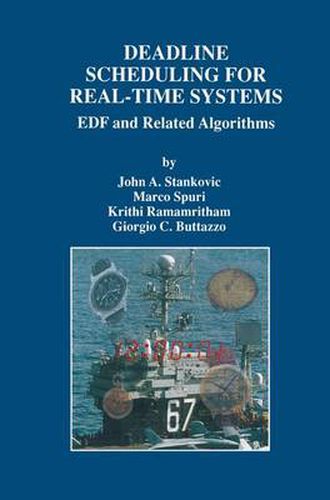Readings Newsletter
Become a Readings Member to make your shopping experience even easier.
Sign in or sign up for free!
You’re not far away from qualifying for FREE standard shipping within Australia
You’ve qualified for FREE standard shipping within Australia
The cart is loading…






This title is printed to order. This book may have been self-published. If so, we cannot guarantee the quality of the content. In the main most books will have gone through the editing process however some may not. We therefore suggest that you be aware of this before ordering this book. If in doubt check either the author or publisher’s details as we are unable to accept any returns unless they are faulty. Please contact us if you have any questions.
Many real-time systems rely on static scheduling algorithms. This includes cyclic scheduling, rate monotonic scheduling and fixed schedules created by off-line scheduling techniques such as dynamic programming, heuristic search, and simulated annealing. However, for many real-time systems, static scheduling algorithms are quite restrictive and inflexible. For example, highly automated agile manufacturing, command, control and communications, and distributed real-time multimedia applications all operate over long lifetimes and in highly non-deterministic environments. Dynamic real-time scheduling algorithms are more appropriate for these systems and are used in such systems. Many of these algorithms are based on earliest deadline first (EDF) policies. There exists a wealth of literature on EDF-based scheduling with many extensions to deal with sophisticated issues such as precedence constraints, resource requirements, system overload, multi-processors, and distributed systems. This volume aims at collecting a significant body of knowledge on EDF scheduling for real-time systems, but it does not try to be all-inclusive (the literature is too extensive). The book primarily presents the algorithms and associated analysis, but guidelines, rules and implementation considerations are also discussed, especially for the more complicated situations where mathematical analysis is difficult. In general, it is very difficult to codify and taxonomize scheduling knowledge because there are many performance metrics, task characteristics, and system configurations. Also adding to the complexity is the fact that a variety of algorithms have been designed for different combinations of these considerations.
$9.00 standard shipping within Australia
FREE standard shipping within Australia for orders over $100.00
Express & International shipping calculated at checkout
This title is printed to order. This book may have been self-published. If so, we cannot guarantee the quality of the content. In the main most books will have gone through the editing process however some may not. We therefore suggest that you be aware of this before ordering this book. If in doubt check either the author or publisher’s details as we are unable to accept any returns unless they are faulty. Please contact us if you have any questions.
Many real-time systems rely on static scheduling algorithms. This includes cyclic scheduling, rate monotonic scheduling and fixed schedules created by off-line scheduling techniques such as dynamic programming, heuristic search, and simulated annealing. However, for many real-time systems, static scheduling algorithms are quite restrictive and inflexible. For example, highly automated agile manufacturing, command, control and communications, and distributed real-time multimedia applications all operate over long lifetimes and in highly non-deterministic environments. Dynamic real-time scheduling algorithms are more appropriate for these systems and are used in such systems. Many of these algorithms are based on earliest deadline first (EDF) policies. There exists a wealth of literature on EDF-based scheduling with many extensions to deal with sophisticated issues such as precedence constraints, resource requirements, system overload, multi-processors, and distributed systems. This volume aims at collecting a significant body of knowledge on EDF scheduling for real-time systems, but it does not try to be all-inclusive (the literature is too extensive). The book primarily presents the algorithms and associated analysis, but guidelines, rules and implementation considerations are also discussed, especially for the more complicated situations where mathematical analysis is difficult. In general, it is very difficult to codify and taxonomize scheduling knowledge because there are many performance metrics, task characteristics, and system configurations. Also adding to the complexity is the fact that a variety of algorithms have been designed for different combinations of these considerations.